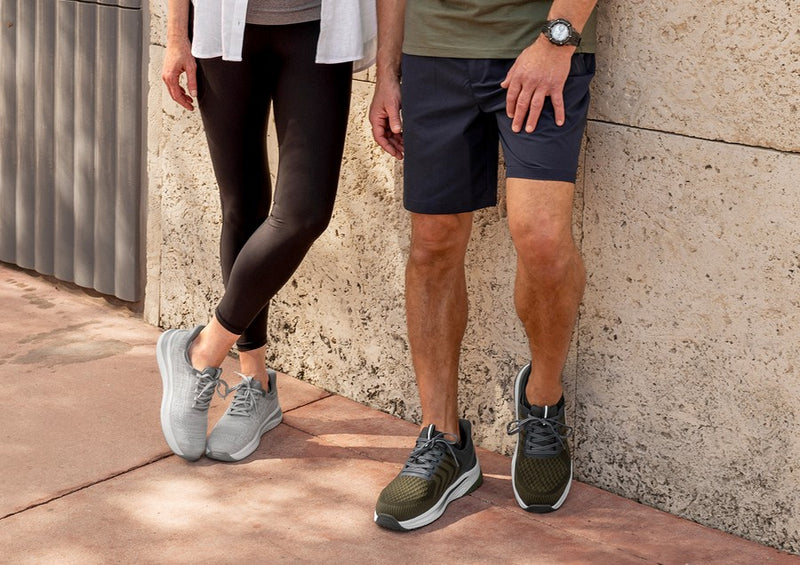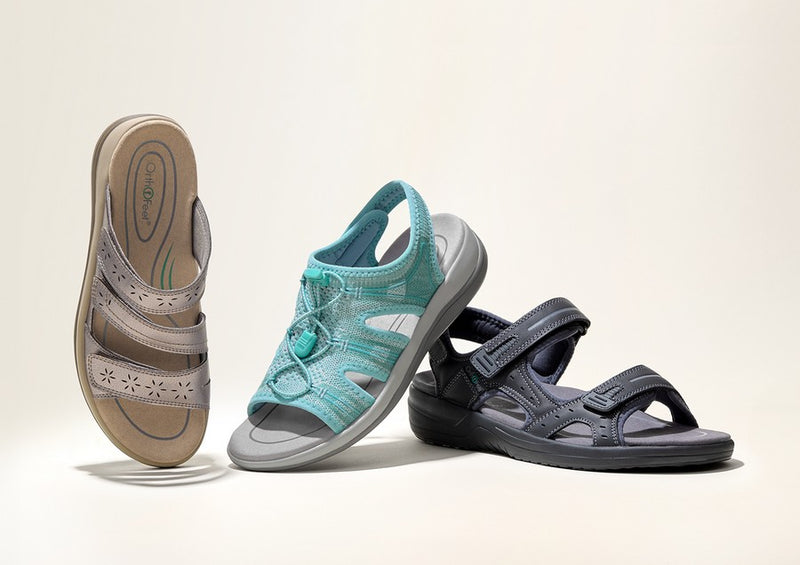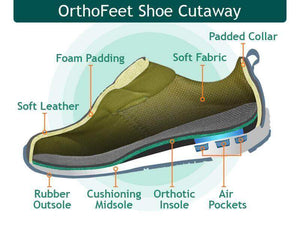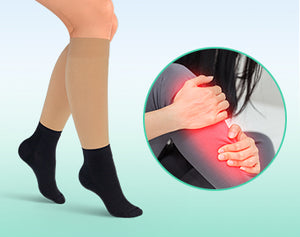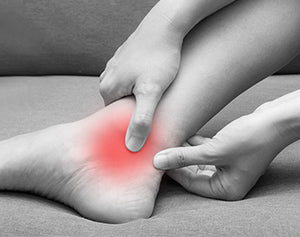The Orthofeet Blog
- All Posts
- All
- Arch Support
- Back Pain
- Bunions
- Diabetes
- Flat Feet
- Foot Pain
- Hammer Toes
- Heel Pain
- Heel Pain/ Heel Spurs
- Knee & Hip Pain
- Knee pain
- Morton Neuroma
- Orthopedic shoes
- Other
- Overpronation
- Plantar Fasciitis
Plantar Fasciitis
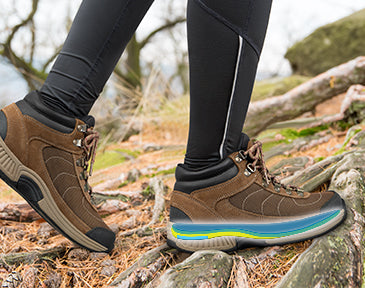

Josh White DPM / August 12, 2021
The Best Hiking Boots for Plantar Fasciitis
The Best Hiking Boots for Plantar Fasciitis Read Post
-
The Difference Between Diabetic Shoes and Regular Shoes
By Steven Gershman DPM / August 15, 2023Navigating the realm of footwear becomes particularly important for people with diabetes, as the wellbeing of their feet demands extra attention. In the quest for comfort, protection and health, the distinction between diabetic shoes and regular shoes is extremely important. In this article, I will shed light on the unique features, benefits and considerations that set these two types of footwear apart. Understanding these distinctions will hopefully help people living with diabetes find the shoes that will keep their feet healthy and comfortable. So, what differentiates diabetic shoes from regular shoes? To understand the difference between diabetic shoes and regular shoes, we must first ask what diabetic shoes are. What are diabetic shoes? Simply put, diabetic shoes are footwear specifically designed to address the needs of individuals with diabetes. People with diabetes are at a higher risk of developing foot related complications due to factors such as reduced circulation, nerve damage (neuropathy), and a decreased ability to heal wounds. These shoes play a crucial role in decreasing the risk of diabetic foot ulcers and, consequently, lowering the likelihood of amputations. They are constructed to offer both support and protection to the feet, while effectively minimizing pressure points. In addition, diabetic shoes typically feature extra depth, which allows ample room for accommodating diabetic inserts or custom orthotics. Still, despite their specialized design, these shoes come in a variety of styles that closely resemble regular footwear, offering both functionality and aesthetics. What makes diabetic shoes different? What makes diabetic shoes different is their distinctive construction, which prioritizes the comfort and wellbeing of people with diabetes. These shoes feature a protective interior crafted from soft and cushioned materials, with no overlays or stitching that remains unobtrusive, to avoid causing skin irritation. Moreover, their design is meticulously crafted to alleviate pressure on the forefoot, ensuring that areas such as the toes, sides of the foot and back of the heel are not subjected to discomfort or irritation. This specialized construction ensures that diabetics can experience both support and relief from potential foot related complications. And this is backed by ample research. In a 2019 review aimed at identifying the literature related to healthcare professionals' recommendations and the use of therapeutic footwear among patients with diabetes mellitus, it was concluded that “Therapeutic footwear for diabetics was able to produce significant reductions of peak plantar pressure in static and dynamic analysis, being more efficient than a common footwear, and could contribute to the prevention of injuries associated with diabetic foot”. Special features of diabetic footwear Diabetic footwear must contain specific features and be designed and constructed in a way that alleviates the foot conditions to which diabetics are prone. The best shoes for diabetics include the following special features and qualities: Protective interior that is made from soft material, and stitching that doesn’t protrude so as not to cause irritation. Non binding uppers that insure that there is no pressure on the foot. In contrast, regular shoes often cause pressure in the forefoot area or the back of the shoe, as they are often constructed from firm materials and in a way that might irritate bunions, the toes, or back of the heel. Extra depth design that provides a pressure-free fit and can accommodate thick orthotic inserts. A deep toe box that provides extra room for toe movement and avoids pressure on the toes. Lightweight, cushioning soles that facilitate mobility and stability, and reduce impacts on the foot. Stretchable uppers might be the ideal solution for conditions caused by severe diabetes or neuropathy. These stretchable shoes conform to the contours of the foot and help eliminate pressure points. Special orthotic insoles that provide arch support, reduce pressure on the bottom of the foot and offer good cushioning. Advantages of diabetic footwear We can now see that the construction and design of shoes for diabetics offer some very attractive advantages. In addition to providing pain relief and enhanced levels of comfort, diabetic footwear can also help do the following: Provide better motion control Promote circulation Prevent skin breakdown Prevent the formation of calluses Reduce the occurrence of foot problems in high-pressure areas of the foot. Yet another benefit that is also worth noting is that diabetic shoes are often covered by Medicare and Medicaid, and by other insurance programs. Are diabetic shoes a must for diabetics? Many people ask me, “Why can’t I just wear comfortable, regular shoes if I have diabetic neuropathy or other foot problems related to diabetes?” The simple answer to this question is another question: why take that risk? Many of the foot problems caused by diabetes can turn into more serious health complications, but they can also be prevented. It is just common sense to take measures that promote better foot health and overall health, i.e., wearing the right footwear. This is especially true when this footwear is often covered by insurance. Can people that don’t have diabetes wear diabetic shoes? Of course! In fact, it is quite common for non-diabetics to purchase diabetic shoes precisely because they provide so much comfort and support. They are also great for foot problems that are not necessarily related to diabetes, such as heel pain, ball of the foot pain, blisters, flat feet, wide feet etc. Real experiences of real people Rather than telling you that diabetic shoes are better than regular shoes for people with diabetes, I will share some reviews from those who have already made the switch. “Amazing shoes! I have diabetes, wide feet and flat arches. This dilemma has put me on a lifelong quest for a truly comfortable shoe. My quest has ended at last! These shoes are remarkable! After a full day on my feet, it’s like I haven't even had shoes on! My feet have never been happier!”, says Donald Roth. “Extremely comfortable slippers. I suffer from neuropathy, back and balance problems. These shoes are very soft, yet firmly designed for just someone like me. They look great & are adjustable if your feet swell. They slip right on so I don’t have to reach down to put them on. They are designed to last forever. Well worth the money”, writes Marian Hartman. “Most comfortable shoe for a person with diabetes or other foot problems. I highly recommend them for everyone who wants a shoe that is comfortable”, writes Ellen Dittbrender. “Excellent shoe. I'm glad to say I own 4 pairs of Orthofeet shoes. They are all excellent. I can honestly say without the Orthofeet shoes I would not be able to walk. I have neuropathy, diabetes and plantar fasciitis. Really a great, comfortable shoe”, says Manny Kornbluth. Join the conversation We would love to hear from you, too! Whether you're a seasoned wearer of diabetic shoes or someone curious about their benefits, your experiences and thoughts are valuable to us and our community. Feel free to share your insights, stories and questions in the comment section below.Read More -
Diabetic Socks - What are they, and why are they needed?
By Orthofeet Team / November 22, 2022Why does someone with diabetes need special socks? While not all diabetics are required to wear diabetic socks, people with diabetes have sensitive feet and suffer from various foot conditions and need to protect their feet more than others. Diabetic socks have unique design features, not found in regular socks, that safeguard the diabetic foot from developing additional problems and help keep it comfortable and healthy. Wearing the appropriate pair of socks is just as important as wearing diabetic shoes! The majority of people with diabetes suffer from diabetic neuropathy and peripheral vascular disease. Neuropathy causes one to lose feeling in the legs and feet by damaging the nerves. Without proper functioning nerves, one cannot sense if something is too hot or too cold or if they have a cut or sore on their feet. Not knowing this can lead to serious infections and complications. Peripheral vascular disease causes the blood vessels to become narrow, decreasing the blood flow to the legs and feet. Decreased blood flow slows down healing of any cuts or sores which increases the chance of developing ulcers. Shop Now for Diabetic Socks What are diabetic socks? Diabetic socks are specially designed to decrease the risk of foot injury, to offer maximum blood flow, and keep the feet dry. The best diabetic socks should have the following features: Seamless: Even the tiniest protrusion can have a severe impact on the diabetic foot. Socks with seams can rub against the skin and can cause blisters or ulcers, which may be harmful for diabetic feet.The best diabetic socks are seamless and knitted with inverse linking, which keeps the ends of the toe-linking thread outside rather than inside the sock. Non-constricting: The fit of diabetic socks should be loose, non-constricting and have a super stretch design. In fact, they should be loose to the point where you barely feel them!.Tight socks can inhibit circulation, which might be challenging for those who suffer from circulatory issues. Padding: Extra padding and cushioning for sensitive areas help prevent injury and enhances comfort. Normally the extra padding runs along the bottom of the sock, around the toes, and at the heel of the foot. These areas of the foot are usually susceptible to the most shock forces during activities and therefore need to be protected even more. Warmth: Diabetes can cause blood vessels to restrict, decreasing circulation to the feet. Diabetic socks should be made from fabrics that keep feet warm and help improve blood circulation. White Sole: A white sole is important for people with compromised sensation, as it helps alert wearers to a draining wound. Stains from infections, open cuts and sores that require immediate attention will be very visible on a white sole. Moisture-wicking: Many socks today are knitted with special yarns that are infused with advanced technology to help maintain a healthy foot. Synthetic yarns such as polyester and nylon are able to move moisture out of the sock and quickly dry up. A dry foot environment helps prevent skin infections and keeps feet comfortable for long periods. Anti-microbial: Good diabetic socks are treated with anti-microbial technology to prevent the growth of bacteria and fungi in the moisture-prone regions of the foot, keeping it healthy. Eliminating bacteria and fungi also eliminates the bad odors in your feet! Soft yarns: Diabetic socks are often made from finer texture fabrics that feel super soft against the skin. Shop Now for Diabetic Socks Since diabetic socks are designed with many special features that make them better than regular socks, it is not surprising that people who do not suffer from diabetes wear them too! HOW TO CARE FOR DIABETIC SOCKS It is highly recommended you wear a fresh clean pair of diabetic socks every day. This will ensure your feet remain clean and dry and allow you to see whether you have any new draining wounds that need attention. The best diabetic socks can be washed with your regular load of laundry, preferably on a warm cycle. It is recommended not to use chlorine bleach and fabric softeners as these chemicals are harsh and will shorten the life of the socks. They can be dried in the dryer on a low heat setting. Check your socks regularly for any holes, rips or loose threads as any protrusion can cause harm to the diabetic foot. OTHER WAYS TO CARE FOR YOUR DIABETIC FEET In addition to wearing diabetic socks, a diabetic should wear diabetic shoes that provide extra protection and comfort for their sensitive feet. The best diabetic shoes should have the following features: Protective Interior: soft, seam free linings with no protruding stitching. Non-Binding Uppers: soft and with no overlays to eliminate pressure points. Stretchable Uppers: provide extra protection since they conform to the contours of the unique diabetic foot shape and help ease pressure points. Orthotic Support: with anatomical insoles that provide superior arch support, conform to the contours of the foot and reduce pressure on the bottom of the foot. Extra-Depth Design: ensures a loose fit that does not apply pressure on the sensitive foot. This design also accommodates custom orthotics comfortably. Deep Toe-Box – the best diabetic shoes should have higher toe area, offering extra room and creating a pressure free environment. Multiple Widths – diabetics should wear wide width shoes to avoid a non-constricting foot environment. Functional Soles - lightweight soles with an ergonomic design that facilitates mobility and improves foot motion. ORTHOFEET, A COMPANY SPECIALIZING IN DIABETIC SOCKS AND SHOES Orthofeet, an orthopedic footwear company, biomedically designs the best diabetic shoes, diabetic insoles and diabetic socks. The products help alleviate the symptoms associated with diabetes, provide the utmost protection for feet and offer soothing comfort from heel to toe. Orthofeet’s diabetic sock collection consists of a variety of styles and colors including ones with extra padding for more sensitive feet, extra roomy socks that provide a comfortable fit for wider legs as well as styles with all around padding from the toe area up to the welt of the sock. All the socks are seam free, loosely knitted and cushioned to provide essential comfort and protection. The collection is available in extended sizes designed to fit shoes from size 4 all the way to a size 15! To explore the Orthofeet diabetic sock collection, click here. The Orthofeet diabetic shoe collection includes men’s and women’s styles: walking shoes for diabetes, sandals for diabetes, casual shoes for diabetes, boots for diabetes, dress shoes for diabetes and much more. Features include a seam free interior, wide shoe shape, extra depth and multiple widths with some styles available in extra extra wide. All Orthofeet shoes are certified by Medicare and qualify as therapeutic shoes under code A5500 of the Diabetic Shoe Bill. To view the collection, click here.Read More -
5 Best Diabetic Socks for Women and Men
Medical information provided by Josh White DPM / October 19, 202237.3 million Americans live with diabetes. That's a little more than 1 in 10 of your US friends, neighbors, coworkers, and loved ones. Half of US diabetics also live with nerve damage caused by peripheral neuropathy. Common symptoms include tingling, numbness, extreme sensitivity and pain in the feet and legs. Peripheral neuropathy can result in foot ulcers and issues with bones and joints. If you have diabetes, what can you do to help prevent peripheral neuropathy? Mayo Clinic recommends getting an A1C test at least twice a year, managing blood sugar levels and practicing healthy foot care. How can you make sure your feet stay healthy? Finding the right socks and shoes is a great start. Thankfully, there are many great options available. Keep reading to find the best diabetic socks Our List of the Best Diabetic Socks 1. Extra Roomy Socks A great solution for those who need a little more space from their socks due to a wider foot, ankle, or calf. The Extra Roomy socks are easy to pull on and won't squeeze calves or feet. The Extra Roomy Socks are made from breathable fabrics with moisture-wicking technology that keep foot odor away. Wearers won't even feel the seams in these socks thanks to their inverse linking design. This means they are completely smooth and seam-free on the inside. So if you see little threads on both sides of the toe area, it's not because they are fraying. The Extra Roomy Gray Socks are designed to provide extra cushion, protection, and comfort for men and women with diabetes. Extra Roomy are available in a multitude of colors to match any wardrobe: charcoal, white, dark brown, light gray, and dark gray. These socks are available in sizes small to extra-large. Shop Extra Roomy Socks 2. Padded Sole Socks For those looking for the ultimate padding and protection, the Padded Sole Sock gives the cushion and comfort you can expect from the best diabetic socks. Just as it sounds, the sock us designed with a thicker material along the entire length, including the heel and forefoot. What’s more, the color of the sole is white which allows the wearer to identify open wounds quickly and easily when they occur. The mid-calf length slides on and off any size foot and calf. The Padded Sole Sock is also made from rayon making it super soft and gentle against the skin. It employs moisture-wicking technology for a healthy foot environment. Dress these socks up or down, just leave a little extra room for the padding in your shoe. The two-toned sock uses interlocking technology to provide a seam-free design. Welcome in soft comfort and keep friction blisters away with the BioSoft Padded Sole Sock. The Padded Sole Socks are available in staple colors: white, charcoal, and dark brown. Shop Padded Socks 3. Casual/Dress Socks If you are looking for increased comfort and protection, but don’t like the thickness of most diabetic socks, the Casual/Dress Socks are the answer. They are functional and versatile, and easily fit in most dress shoes for men or women. They're still cushioned but are thinner than other casual socks. Since they are a little thinner, the Casual/Dress socks work well during warmer seasons. Their midcalf length is perfect for those who don't want any gaps between slacks or long pants and their socks. These machine-washable socks are made from soft, moisture-wicking materials. Like other diabetic socks, they're anti-microbial, making sure your feet stay healthy. The white sole will help you track changes to your feet, which is crucial for maintaining a healthy foot and keeping tabs on your diabetes. Take your pick! Casual/Dress socks are available in charcoal, white, dark brown, light gray and dark gray. Shop Casual/Dress Socks 4. Low Cut Socks The best diabetic socks don't have to be crew or dress height. These Low Cut Socks offer a discreet way to wear the best socks for diabetic neuropathy. Rayon materials and brushing techniques make the fibers of these socks soft and comfortable. The seamless construction makes them friendly to diabetic feet and will not irritate the skin. These socks are cushioned but still thin and will fit comfortably in dress shoes, sneakers and flats. The Low Cut Socks are great for those times you don't want a sock showing halfway up your shin. They are designed with a non-slip silicone at the heel to ensure they don’t slip, as well as a slightly higher heel tab, providing extra protection in the heel area. The Low Cut Socks are available in black and white, perfect for any wardrobe and shoe. Shop Low Cut Socks 5. Foot Warmer Socks Podiatrists always recommend protecting your feet and never be barefoot, even when you are at home. But sometimes, you just want to relax on the sofa or to stay in bed and you don’t really need to wear shoes or slippers. For these times, we recommend the Foot Warmer Socks. They are made with super soft plush material to keep feet cozy and comfortable. Designed with stretch fabric, these socks fit over any foot shape and will expand even when your feet swell. And to ensure feet are kept dry, clean and fungus free, the sock fibers are made with Dry-Plex technology. Shop Foot Warmer Socks What are the Best Socks for Diabetics to Wear? From a first glance, diabetic socks might seem like regular socks, but when you look closely you will see special features that accommodate the diabetic foot. The best diabetic socks should have a good cushion, loose fit and smooth or no seams. They should be easy to put on and take off. The best socks for diabetic neuropathy shouldn't be too restrictive. They should allow for good circulation and blood flow. Socks to help with diabetic neuropathy should also be made of soft and comfortable materials, ideally moisture-wicking and breathable. There are several key features to look for in your diabetic socks for neuropathy that will help keep your feet comfortable and pain free. Cushion: The best diabetic socks for men and women should have extra padding to offer increased protection to the sensitive foot. Extra cushioning along the entire bottom of the sock is ideal, but the most important areas are the heel and toe area. These areas are prone to excess pressure when the foot strikes the ground at the heel and lifts off at the toes, which can lead to injuries and foot ulcers. Stretchy and Comfy: Diabetic socks for neuropathy shouldn't be too tight. The best diabetic socks need to be loose-fitting so that they promote blood flow. They should slide on and off easily without bunching up or squeezing any part of the foot and leg. Socks with stretch are best as they can expand when the diabetic foot swells throughout the day. Stay away from excess elastic and other constricting materials. A good way to tell if your socks are too tight is to see if you develop rings or indentations around the instep, ankle or calf after wearing them for several hours. Remove Excess Moisture: Socks with moisture-wicking technology are a must for keeping your feet clean and dry. If your feet perspire, bacteria and fungi can build up, which also causes odor, and you could end up with ulcers and other issues. Making sure your feet stay warm and dry is vital in a good pair of diabetic socks. Soft Material: Socks should be made from soft material that won't irritate your skin. Breathable and comfortable fabric keeps your feet healthy and dry. Seamless: While seams may not seem like a big deal, they have a role in choosing the best diabetes socks of 2022. Neuropathy causes one to lose sensation at the feet, which means that even a tiny thread can lead to skin irritation, causing ulcers, sores and other issues. Socks with seams have the potential to restrict blood flow, so it's best to go seamless. Bacteria Prevention: As mentioned earlier, the best diabetic socks are made from materials that prevent bacteria. Excess bacteria can lead to infection. It's important to use materials with antibacterial or antimicrobial properties Keep Warm: Extreme temperatures can be hard on the feet. Those with neuropathy are more sensitive to temperature extremes. The best socks for diabetics should keep the feet warm. Why should diabetics wear white socks? Seeing as diabetics tend to develop a variety of foot problems, it’s recommended that they take their foot care seriously and wearing white socks can help them do that. Most diabetics have reduced sensitivity in their feet, which means they may not feel wounds or injuries such as cuts, scrapes, bruises and more. If such injuries aren’t treated, it could lead to infection and complications. The logic behind white socks is simple: they allow diabetics to easily notice blood or discharge from wounds and injuries they may not feel, and treat them as early as possible. When should you wear diabetic socks? If you are diabetic, you may benefit from only wearing diabetic socks when: Your feet are frequently moist or sweat often. Your foot’s color or temperature changes. You experience foot irritation, wounds, blisters, fungal infections or nerve damage. Still, it’s important to note that even if you don’t experience any of these problems and you are diabetic, it’s a good idea to wear diabetic socks when you’re traveling, spending long hours on your feet and physically active. How long can you wear diabetic socks? Diabetic socks are socks with extra and unique features compared to regular socks, so you’ll only benefit from wearing them! This means that anyone can wear diabetic socks and for as long as they want. If you need diabetic socks, you should wear them daily and change into a fresh pair every day. Which is better, compression socks or diabetic socks? It’s best to consult with a doctor to determine whether or not compression socks are a good solution for you. While both socks have health benefits, they are quite opposite in what they are designed to do. The aim of diabetic socks is to prevent irritation, protect your feet and prevent moisture and pressure, in a non constricting fit. The aim of compression socks is to keep swelling and fluid retention at bay by pushing the blood up the leg, prevent blood clots and protect the feet from infections and sores. Diabetic socks are not tight-fitting like compression socks, which are typically recommended to diabetics with circulation problems and swelling. Keep Your Feet Healthy Wearing the right socks plays a big part in keeping feet healthy. If you have diabetes, you can take additional steps to stay on top of your foot health. Daily Foot Checks Check your feet every day. If you can't see the bottoms of your feet, use a mirror or ask a loved one to check them out for you. You could have a small cut or blister you're unable to feel, especially if you have neuropathy. Your feet should be clear of cuts, scrapes, or blisters. If you notice any of these things on your feet, make sure they're healing properly. Always contact your doctor right away if something on your feet is different or shouldn't be there. Not Too Dry Feet that get too dry can crack, which leaves more risk for infection. Apply a thin layer of moisturizer to your feet as often as you and your doctor decide necessary, to keep your feet healthy. There's no one-size-fits-all answer to how often your feet may get dry. Skin dryness varies with each person, climate, and season. Talk to your doctor about a daily foot routine that works best for your situation. Tidy Nails are Happy Nails Keep your toenails trimmed. Never cut your nails too short. It is best to cut them to the shape of the end of your toes. Don't cut them straight across or curved down the sides. If you can't reach or see your toenails clearly, arrange to have a podiatrist clip them. You should keep these regular appointments. Never attempt to clip your own toenails if you have difficulty seeing them or reaching them. This could cause you to accidentally cut your skin, leaving you susceptible to infection. Barefoot is Not Best If you have diabetes, you should wear good-fitting socks and shoes at all times. If you don't like wearing outdoor shoes in the house, invest in a pair of slippers with arch support and cushioning. Going barefoot can cause stubbed toes or cuts. This, as we know, leaves you at risk for infection. Sitting Down? Feet up! Keep your feet elevated to encourage good circulation. If you're sitting down, elevate your feet on an ottoman, chair, or stack of pillows. Wiggle your toes and move your feet while they're elevated. Keeping good circulation helps fight off neuropathy. And Don't Cross 'Em Crossing your legs for long periods of time decreases blood circulation. Remember to keep your legs uncrossed as much as possible, to promote better blood flow. Don't Take Matters into Your Own Hands (or Feet) If you notice corns or warts on your feet, don't try to remove them yourself. Over-the-counter products can burn your skin. Instead, call your doctor. Your medical professional will be able to prescribe the best treatment for your situation. Foot-Friendly Fitness Make sure to keep your exercise foot-friendly. This looks different for everyone. Check with your doctor to see what kinds of physical fitness are best for you. Fresh and Clean Wash your feet daily with warm water and soap and make sure the water isn't too hot. After you clean your feet, pat them dry and apply lotion to the bottoms only. Lotion between your toes could lead to infection. Get Into a Groove Foot health practices are much easier when they become routine habits. Try to establish a foot routine. Check your feet when you're getting dressed in the morning and again before you go to bed. Also, write podiatry appointments on your calendar and arrange a way to get there if you can't drive yourself. The Right Shoes Wearing shoes and socks that fit well is vital to good foot health. Diabetic shoes are not like ordinary shoes and are designed with unique features to keep sensitive feet protected, comfortable and pain free. Look for shoes from brands that offer solutions for foot conditions, including diabetes. The best diabetic shoes are meticulously designed with innovative features to offer maximum comfort and protection. A premium orthotic insole, thick cushioning, a soft and gentle seam free interior, wide toe box and much more are special features that are best for diabetics. Finding the right shoes is half the battle, but getting them to fit your feet perfectly is another challenge. Most shoe brands only offer the standard width and a narrow silhouette, which most times do more harm than good. A good orthotic shoe brand will offer extended widths, up to extra extra wide, to accommodate wide or swollen feet, as well as bunions and hammertoes. The same goes for your socks. Find the best diabetic socks for you by paying attention to fit and materials. Make sure the socks you're wearing pair well with your shoes. Thinner (but still cushioned) socks are better for dress shoes. Thicker socks are more appropriate for sneaker-style shoes. What's the Point? Avoid shoes with pointed toes or a slim shape. Those with diabetes should also avoid high-heeled shoes and shoes without support. Try instead to find shoes with built-in orthotic support and padded cushion. Shoes that feature straps or laces will be easier to adjust to your comfort level and fit. Note that shoes with straps in multiple places offer a custom fit to any foot shape. The more straps, the better. In this day and age, you don’t have to compromise on looks and it is possible to find fashionable orthotic shoes that are also healthy for your feet. After all, you shouldn't have to choose one over the other. When To Worry Staying on top of your health is important. Sometimes, you shouldn't wait to address changes or symptoms with your doctor. According to the CDC, you should contact your doctor right away if you experience any of the following symptoms. Color or temperature change in your feet Foot pain, tingling, or burning Cracked or dry skin on or around your feet An ulcer, blister, sore, corn, or any other type of foot sore An ingrown toenail Hair loss on your legs, toes, or feet Any type of fungus-looking infection (like Athlete's foot) Yellow toenails Foot shape changes over time Any loss of sensation: hot, cold, touch Pain in your legs or cramping in your buttocks, thighs, or calves during physical activity Cramps or pain in legs, calves, thighs, or backside while engaging in physical activity Leaving any of these symptoms untreated could lead to serious complications. It's important to address any of these symptoms with your healthcare provider immediately.Read More
